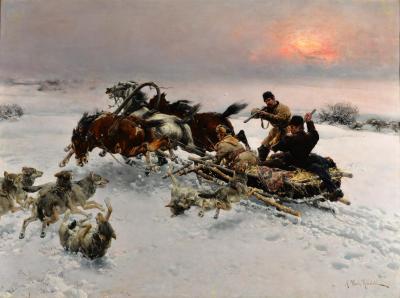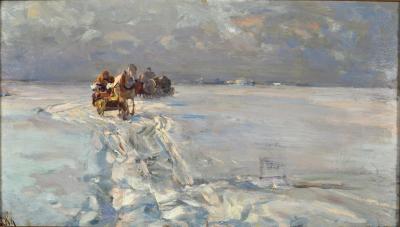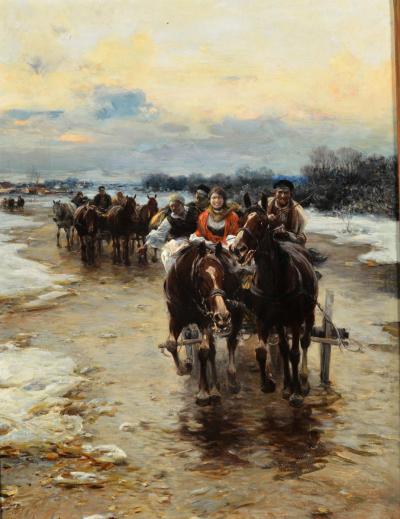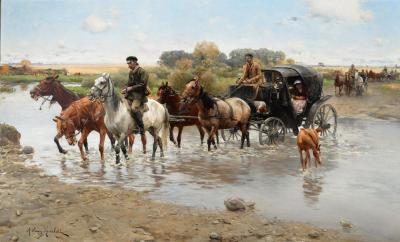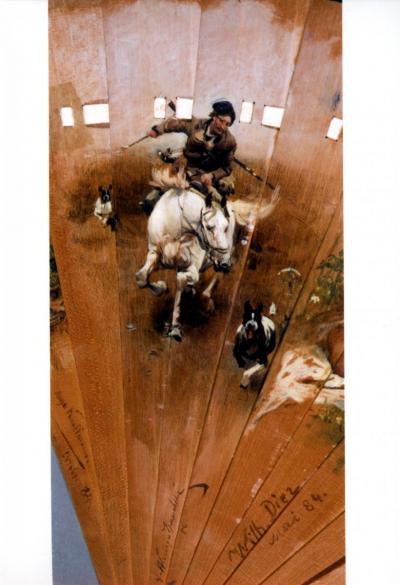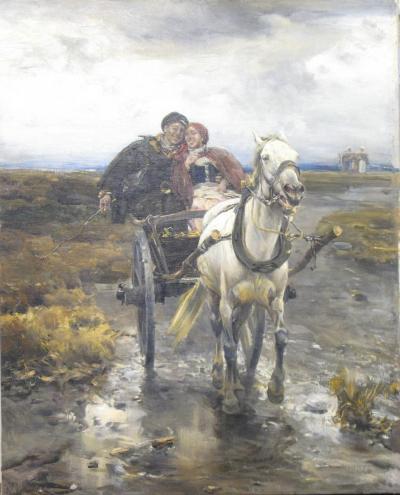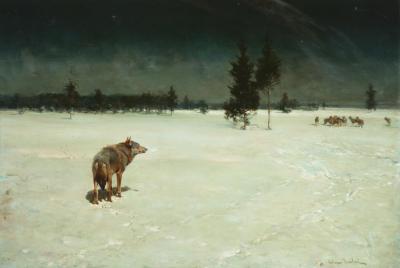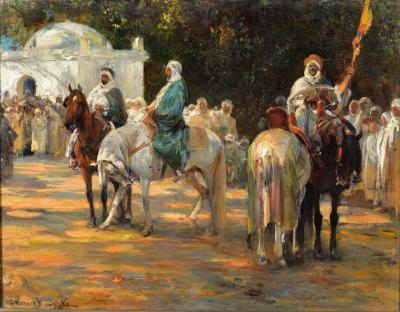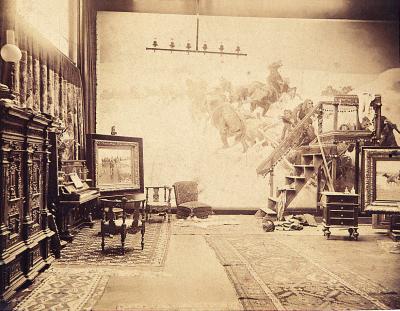Alfred Wierusz-Kowalski
Mediathek Sorted

Wierusz-Kowalski studied for roughly one and a half years in Wagner’s workshop, which was very popular amongst Polish students.[15] This was also the period in which Józef Brandt[16] trained (he was a few years older). Brandt’s works influenced the works made by Wierusz-Kowalski as a student: Zaloty [Courtships] (Ill. 9)[17] and Na zwiadach (On the Outposts, Ill. 10) [18].
The young artist’s early years in Munich were a period of artistic self-discovery. Like many other contemporaries he was temporarily fascinated by the works of Maksymilian Gierymski .[19] Taking him as an example, he painted hunting and riding scenes in elegant 18th-century costumes (Ill. 11), thus in the so-called “late rococo style”, and scenes against the background of small Polish towns (Ill. 12). He used a now missing picture by Gierymski as an inspiration for his painting Wypadek w podróży [Travel Mishap] (Ill. 13).[20] Late rococo style paintings made until the end of the 1970s were fascinating on account of their use of delicate light in the early Autumn landscapes featuring elegant riders in red jackets on lean horses amongst pale golden groves of birch trees and sniffing hunting dogs. But gradually the artist liberated himself from this type of portrait and around 1880 he began to take an interest in motifs from the distant Caucasus. The new protagonists in his pictures were riders crossing rocky mountain landscapes. This had something to do with the war in the Caucasus that was closely followed in Europe.[21] Józef Brandt’s workshop contained a remarkable collection of weaponry, uniforms, traditional costumes and weapons used by Caucasian warriors, which had once belonged to the painter Theodor Horschelt. Wierusz-Kowalski used these exhibits for his pictures featuring Circassian themes (Ill. 14). In this connection the photographic estate of the painter’s family contains pictures of persons modelling as Cossacks. Independent of this, during this time and similar to his work in Prague, Alfred Wierusz-Kowalski painted simple, moving genre scenes in the spirit of Biedermeier, many of which were reproduced in the Polish press. Furthermore he continually took up motifs from the January Uprising, now and later (Ill. 15).[22]
In the second half of the 1970s Alfred Wierusz-Kowalski (Ill. 16) started a family. He married Jadwiga (Ill. 17), the daughter of the writer and journalist, Wacław Szymanowski. His well-known father-in-law had a lot of connections. In this respect he proved to be a great support in helping the artist to rapidly develop his career, although many people held this against the artist. The young couple decided to settle in Munich. Children were born into the world (Ill. 18), and with every new arrival the family moved into a larger apartment.[23] The growing workshop, well furnished and filled with pictures and artists utensils, was not only a place of work: the artist also used it to present his own works to visiting collectors, art merchants and purchasers. The Wierusz-Kowalski’s had an open house that was regularly visited by young people whom the artist was only too ready to help. In 1885 Olga Boznańska arrived in Munich with a written recommendation. As a token of gratitude for his help she made a portrait of his son Czesław in her second apartment in Paris, where Czesław was studying at the time.
[15] Over thirty Poles studied under him. He was the most popular choice as a Professor amongst students at the Academy.
[16] Józef Brandt (1841–1915), Polish battle and war painter. Student of Franz Adam, whose work enjoyed a great success in Munich.
[17] Zaloty, 1875–1877, oil on canvas, 50 x 42 cm. Private collection.
[18] Na zwiadach, 1877, watercolour, gouache on paper, 23.7 x 21.7 cm. Private collection.
[19] Maksymilian Gierymski (1846–1874), painter, author of realistic scenes of Polish uprisings as well as hunting scenes and compositions against the background of Polish small-town scenery.
[20] Wypadek w podróży, 1873, oil on canvas, 56.5 x 101 cm. Muzeum Narodowe, Warszawa [National Museum of Warsaw]
[21] Poles kept a particular eye on this war because the unequal battle between the Circassians against the overwhelming forces of the Russians awoke their yearning for their lost freedom.
[22] The uprising against the Russian occupying power broke out in January 1863.
[23] The couple had five children: Janina (*1879), Michalina (*1880), Czesław (*1882), Józef (*1885) and Jerzy (*1892).

















































































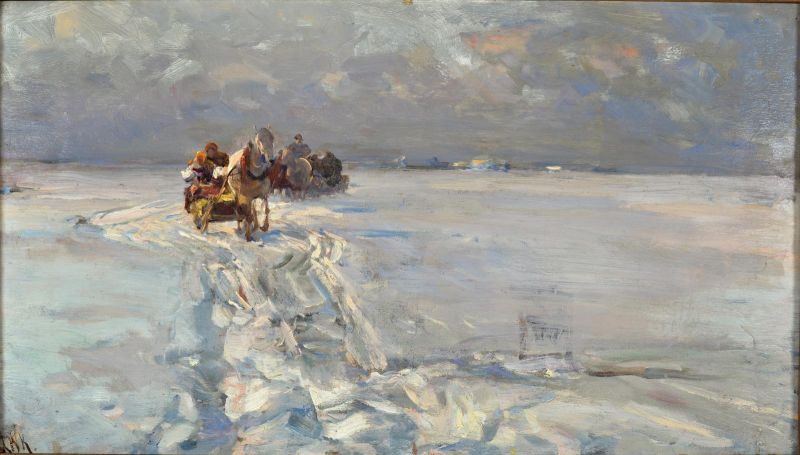
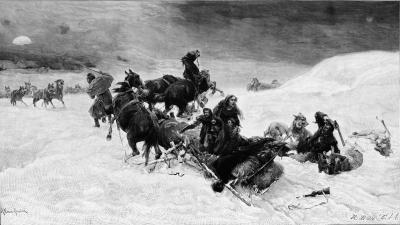
![Abb. 2 Abb. 2 - Widok Suwałk od strony Augustowa [Ansicht von Suwałki von Augustów gesehen], Lithographie von Alojzy Misierowicz, Album Augustowskie, 1855](/sites/default/files/styles/width_100_tiles/public/assets/images/2._widok_suwalk.jpg?itok=cW90QpH5)
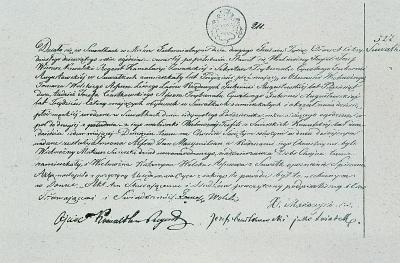
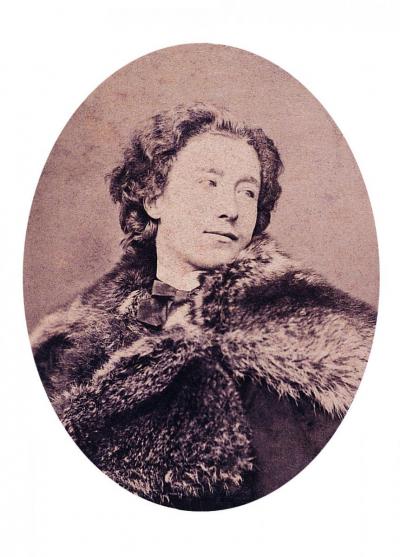
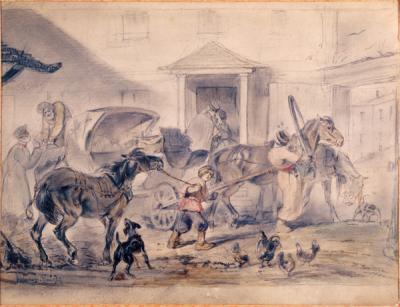
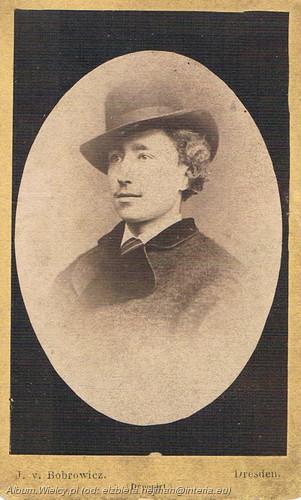
![Abb. 7 Abb. 7 - Dziewczynka z fiołkami [Mädchen mit Veilchen], 1873, Öl auf Leinwand, 50 x 38 cm](/sites/default/files/styles/width_100_tiles/public/assets/images/7._dziewczynka_z_fiolkami_1873.jpg?itok=nBTeOkwF)
![Abb. 8 Abb. 8 - Powrót kwestarza [Die Rückkehr des Gabensammlers], 1873, Öl auf Leinwand, 42 x 65,8 cm](/sites/default/files/styles/width_100_tiles/public/assets/images/8._powrot_kwestarza_freigestellt.jpg?itok=3GHBbJc1)
![Abb. 9 Abb. 9 - Zaloty [Liebeswerbungen], 1875–1877, Öl auf Leinwand, 50 x 42 cm](/sites/default/files/styles/width_100_tiles/public/assets/images/9._zaloty_1875-7_ok._50x42_cm.jpg?itok=rgpvJS6p)
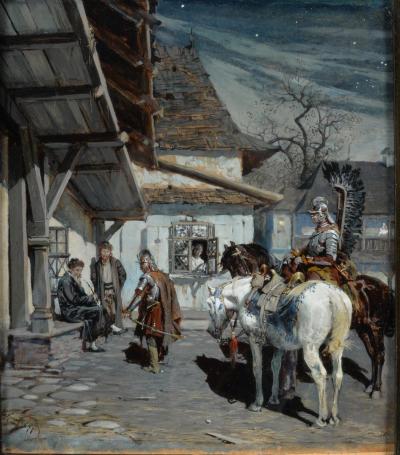
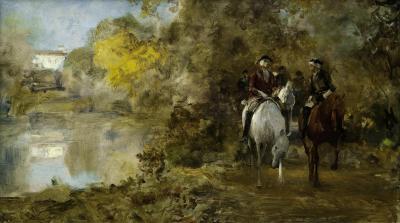
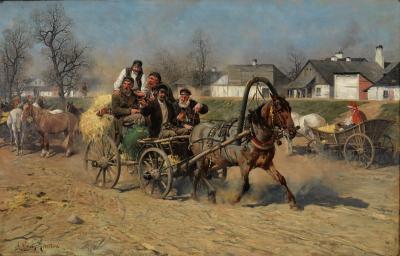
![Abb. 13 Abb. 13 - Wypadek w podróży [Reisemalheur], 1873, Öl auf Leinwand, 56,5 x 101 cm](/sites/default/files/styles/width_100_tiles/public/assets/images/13_wypadek_w_podrozy_freigestellt.jpg?itok=RjSzDhMo)
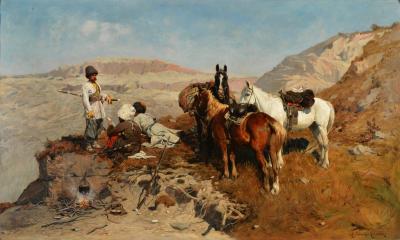
![Abb. 15 Abb. 15 - Postój powstańca [Rast eines Aufständischen], Öl auf Holz, 20 x 35 cm](/sites/default/files/styles/width_100_tiles/public/assets/images/15._postoj_powstanca_freigestellt.jpg?itok=4CUo6v0d)
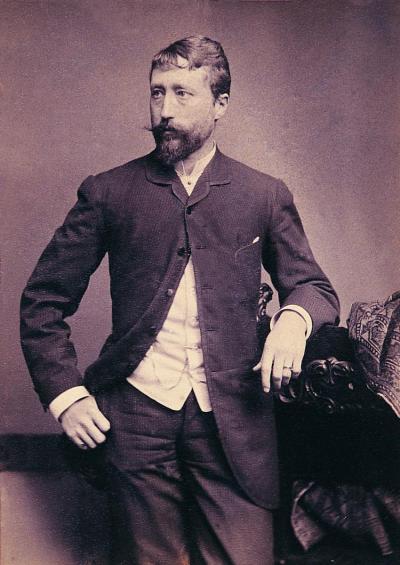
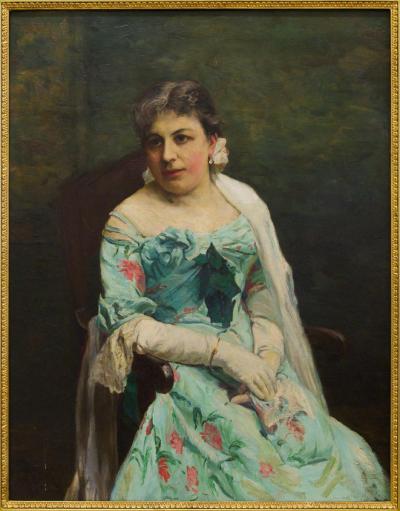
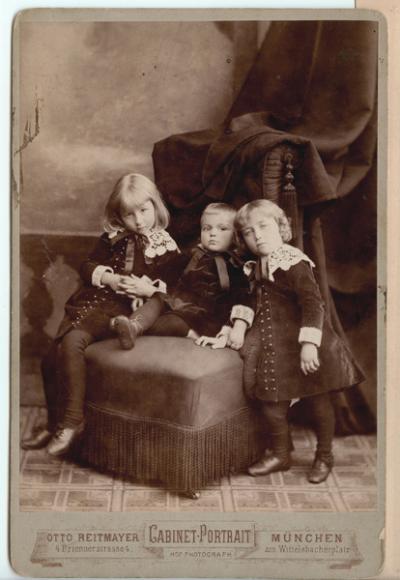
![Abb. 19 Abb. 19 - Wyprawa na niedźwiedzia [Bärenjagd], vor 1889, Öl auf Leinwand, 102 x 73 cm](/sites/default/files/styles/width_100_tiles/public/assets/images/19._wyprawa_na_niedzwiedzia.jpg?itok=XZWS2Zcy)
